Uranium stocks for the next bull market
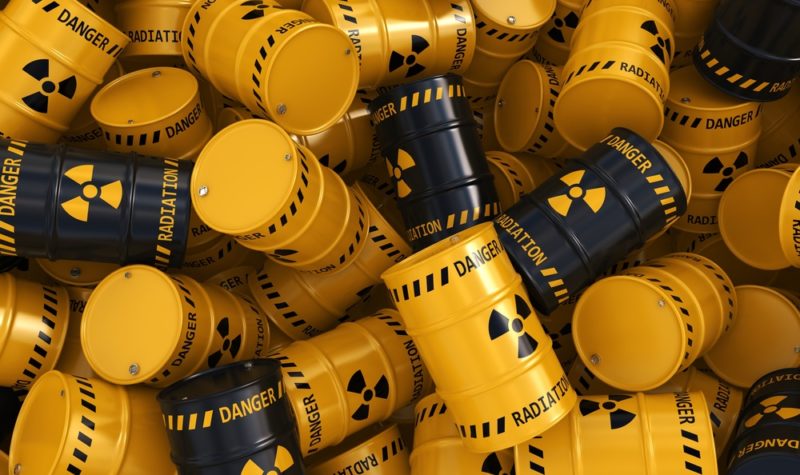
To follow our Magazine article on Uranium, here are some more thoughts…
How to invest for what most observers think is an inevitable uranium price recovery in the next few years is not an easy question to answer. Given the long decline in the uranium price after Fukushima, its not surprising that practically all companies exposed to it – miners as well as producer/refiners – have seen similar declines in their shares. Some countries have banned uranium mining altogether as well as nuclear generation, causing some smaller explorers to go bust.
An important point to note about the ‘published’ price for uranium is that it is a ‘spot’ price referring only to intermittent deals in the market, usually on behalf of users looking to fill in gaps in their requirement. Nuclear generators have to ensure their supplies many years ahead, so make deals that are hardly ever disclosed, at prices probably well above any ‘spot’ price, which can’t therefore be much of a guide to underlying movements in the market. In other words, industry insiders might see an improving market before it is reflected in the spot price, making timing an entry into specific companies that much more difficult for an individual outside investor.
Here, for instance, is a chart from one of the two organisations tracking what is known of ‘long-term contract prices’, showing its estimate against ‘spot’ prices over the last five years.
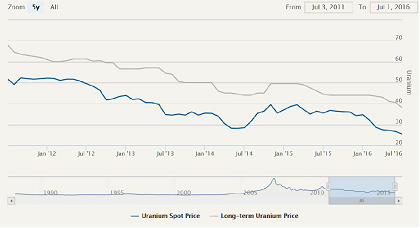
Uranium spot price (lower) v long term contract price
Thus, against today’s $25/lb spot price, Berkeley Energia (LON:BKY) (which I flagged back in January at 24p – now 43p) is assuming for its Salamanca project a contract price which starts at $39/lb as early as next year – rising over the life of the mine to $67/lb in 2030. Let’s hope it is correct, because BKY is one of the few explorers to have seen its shares rise this year as what looks like its compelling profitability at those prices has been digested by the market. It is also one of the few explorer/developers to have been bought by the equally few ETFs and managed funds (described below) which offer uranium exposure for investors.
Uranium Futures
Having said that, what about uranium futures – are they any guide? There are no charts, but data indicates futures for spot uranium rising from $25.4 today for settlement this month to $31.4/lb in five years time. At spot’s apparently stable historic 30% or so discount to long-term prices, that might indicate $45/lb for BKY’s contract price in 2021.
ETFs
As for investing in individual companies, we have already mentioned the obviously dominant giant Cameco (NYSE:CCJ), probably the ‘purest’ exposure to all parts of the uranium chain, whose shares held up fairly well after Fukushima but which have been affected more recently by its own production problems.
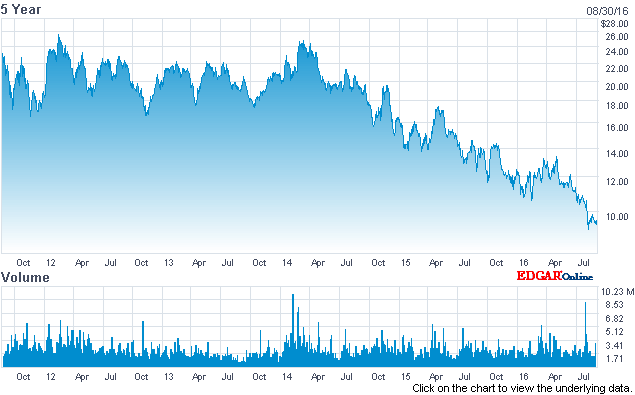
Cameco – last five years
As for the others, share prices for the more attractive companies have been distorted in recent months by the Chinese who have been buying up exploration prospects in Athabaska and Western Canada and the US where some of the world’s best uranium deposits are found, together with stakes in major explorer/producers such as Fission Uranium (TSE:FCU) and NexGen (TSE:NXE).
At the same time, Chinese $40bn market cap coal miner Shenhua Coal is negotiating with CNNC (China National Nuclear Corp) and CGN (China General Nuclear Power) to fund their nuclear related projects, perhaps the start of a trend for yet more diversification from coal to nuclear world-wide.
Apart from these and those we mentioned in the main article, there is a variety of companies who rely on uranium for a substantial portion of their revenues. US based Uranerz Energy Corporation (NYSE:URZ) mines and refines uranium while Uranium Energy Corporation (NYSE:UEC) mines more globally in Canada and S. America.
But perhaps the best guide to the most promising individual companies are the specialist Exchange Trading Funds (ETFs) like the Global X Uranium equity fund (URA) and the Van Eck Uranium Vectors ETF (NLR).
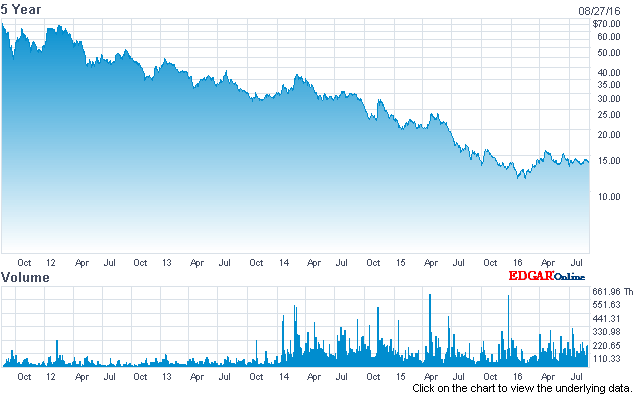
URA Global Uranium ETF
URA Global Uranium ETF
One can see why the URA fund has performed as it has, because its policy is “to provide investment results that correspond generally to the price and yield performance of the Solactive Global Uranium Total Return Index, which is designed to measure broad-based equity market performance of global companies involved in the uranium industry.”
URA’s top ten holdings currently are Cameco Corp, Paladin Energy Ltd, NexGen Energy Ltd, Ur-Energy Inc, Uranium Participation Corp, Uranium Energy Corp, Denison Mines Corp, CGN Mining Co Ltd, Fission Uranium Corp, and, interestingly, Berkeley Energia Ltd.
Obviously an investment now would be in hope of the anticipated rise in the uranium price.
By contrast, the performance of Nuclear Generators ETF (NUCL), now replaced by VanEck Uranium & Nuclear energy vectors ETF (NLR), has reflected that of nuclear generators as well as uranium explorers.
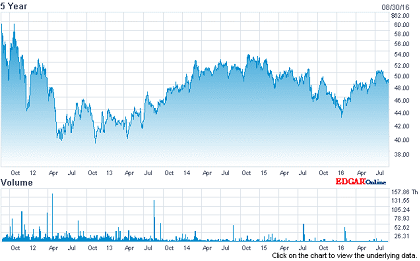
VanEck Uranium & nuclear vectors ETF
Thorium?
I haven’t mentioned Thorium yet, once the great white (it has a whiter colour than Uranium metal) hope to replace (more accurately mitigate) uranium’s radioactive disadvantage, whose explorers enjoyed a brief stock market love affair a decade ago before it became clear that its economics can’t stand up against present day uranium reactors. Even so, India which has large deposits of thorium, is pressing on with attempts to make it work, but whose outcome won’t be known for at least another ten years.
Possibilities nearer to home
Because the more obvious larger explorers in America have been affected by Chinese M&A activity, investors might be more comfortable investing in UK or Australian companies. Berkeley Energia, who I’ve already mentioned, has been weakening lately because ‘activists’ are on the march against its Salamanca mine. And although that is probably not a serious threat, a more significant influence on the shares will be thoughts about the financing for Salamanca which the CEO has been mentioning as hopefully coming from the Chinese, but where nothing has been forthcoming so far.
BKY, being based in Europe, was fairly unique among uranium developers, as also until last year was Forte Energy, which had various uranium exploration ventures elsewhere, but in 2015 took over European Uranium Resources for its promising Kursiskova deposit in Slovakia which was ideally placed to provide fuel for East European nuclear generators. EUR having ploughed funds into it, the Slovakian government banned all uranium mining, so FTE had to be rescued last month by BOS Global Holdings (LON:BOS), an Australian company in a totally different field, although it still holds 45 Mlbs of uranium resources in West Africa. Investors are expecting some sort of corporate action in the near future, although details of the new company’s strategy are lacking at present.
But perhaps the best way into uranium for a UK investor now is specialised fund Geiger Counter Ltd (AIM:GCL), which invests “primarily in the securities of companies involved in the exploration, development and production of energy, predominantly within the uranium industry.” It is only around £11m market cap at the current 18p, so, while currently invested in some of the same underlying stocks as URA, it is likely to be more fleet of foot than its larger counterparts, which is probably why its shares have been outperforming its peers recently.
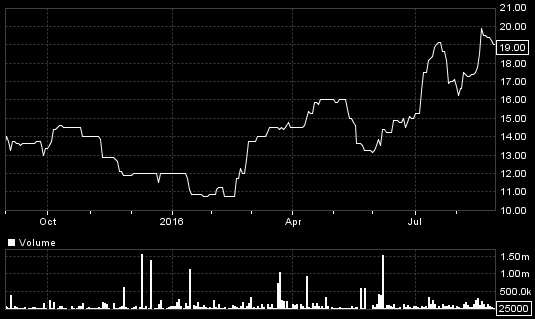
GCL over last year
Apart from these opportunities for a more direct exposure to uranium to add to those in our Uranium feature last month, here are thumbnails of some of the other larger players. I have not reviewed them closely so don’t make any recommendations here.
France’s AREVA (EPA:AREVA) holds stakes in various uranium properties around the world and has deals with other large players like China National Nuclear (CNNC). In Canada, it owns 30% of the world’s largest mine, McArthur River, and a 51-percent stake in the world’s second-largest, Tortkuduk and Myunkum in Kazakhstan, through a joint venture with Kazatomprom. It also owns the SOMAIR open-pit mining operations in Niger which produced 5 percent of world uranium output in 2014.
BHP Billton’s (LON:BLT) Olympic Dam copper-uranium mine in Australia is one of the largest in the world producing 6 percent of world uranium output in 2014, although its low price has forced cutbacks subsequently.
US based Uranium One was acquired in 2013 and taken private (in controversial circumstances) by the Russian state nuclear operator Rosatom, and now holds projects in Kazakhstan, Tanzania, and the USA. Its 50% owned Budenovskoye 2 mine in Kazakhstan is one of the world’s lowest cost producers, accounting for 4 percent of world output in 2014.
Paladin Energy’s (TSX:PDN, ASX:PDN) Langer Heinrich mine, located in Namibia, is another large producer accounting for 4% of 2014 world output. China’s CNNC has a 25% stake.
Rio Tinto’s (LON:RIO) 68.6% owned Rössing mine in Namibia is the world’s longest-running open-pit uranium mine having produced the most uranium of any single mine to date.
Energy Fuels (TSX:EFR) is the second-largest supplier of uranium in the US with various properties in the mid-west, while Ur-Energy (TSX:URE, NYSE:URG) also has uranium projects there, one of which recently produced its millionth pound of uranium. Uranium Resources (NASDAQ:URRE) is another similar operator.
An Australian newcomer is Peninsula Energy (ASX:PEN) who has large long-term supply contracts with two US nuclear generators.
Some smaller up-and-coming uranium explorers and producers to consider might include the following:
Anfield Resources (TSXV:ARY) aims to become a near-term and top-tier uranium producer in the USA having embarked on an acquisition programme which the company describes thus: “our carefully-selected projects are positioned to benefit from renewed US interest in clean nuclear energy and domestic uranium producers, and the strengthening global uranium market.”
Forum Uranium Corp (TSXV:FDC) is a Canadian-based energy company still at the exploration stage with a focus on the acquisition, exploration and development of projects in the Athabasca Basin (where it has a JV with Rio Tinto) Saskatchewan and the Thelon Basin, Nunavut. Other JVs are with Areva, Bexgen, and Cameco as part of its strategy to discover near surface uranium deposits with nearby existing infrastructure through strategic partnerships and joint ventures.
Kivalliq Energy (TSXV:KIV) has spent $55m over the last eight years to explore its flagship project, Angilak in Nunavut, which now has a 43 Mlb resource at 0.69% U3O8 although no plans to develop it as yet.
Plateau Uranium (TSXV:PLU) is attracting interest for its uranium and lithium exploration in Peru, where a 125Mlb uranium resource at Macusani was the subject of a recent PEA pointing to a lower cash cost than, for example, Berkeley Energia’s Salamanca project, compared with which its NPV is greater even at a considerably lower assumed uranium price. A preliminary mine plan and a preliminary feasibility study due soon shows that the company is serious about developing its project, which makes it interesting at its present low market cap of only $CAN14m.
Western Uranium Corp (CN:WUC) – current market cap $CAN37m – was formed only in 2014 with the support of Palisade Global Investments to acquire and develop uranium resources in Utah and Colorado and has already assembled seven past producing mines with resources exceeding 100 Mlbs. With access to an existing mill and permits for a new mill the company claims to be able to start producing by early 2017.
Last up is Uranium Participation Corp (TSE:U) – market cap $CAN460m – which does not mine but invests in uranium oxide in concentrates (“U3O8“) and uranium hexafluoride (“UF6“), with the objective of achieving appreciation in the value of its uranium holdings through increases in the uranium price.
As is to be expected its shares have not done particularly well over recent years, although having fallen by only 20% since 2012 it has outperformed the sector generally.
Comments (0)